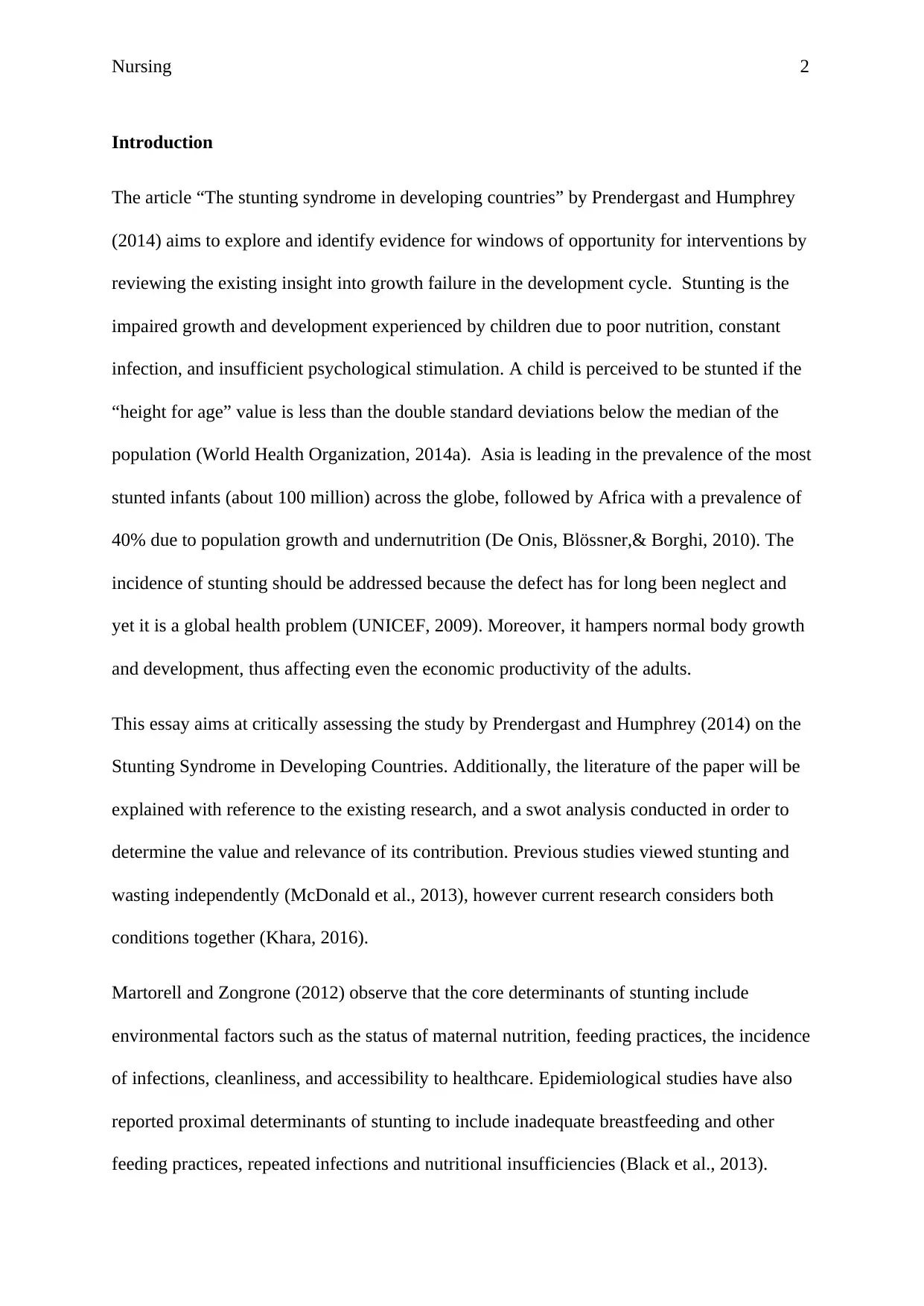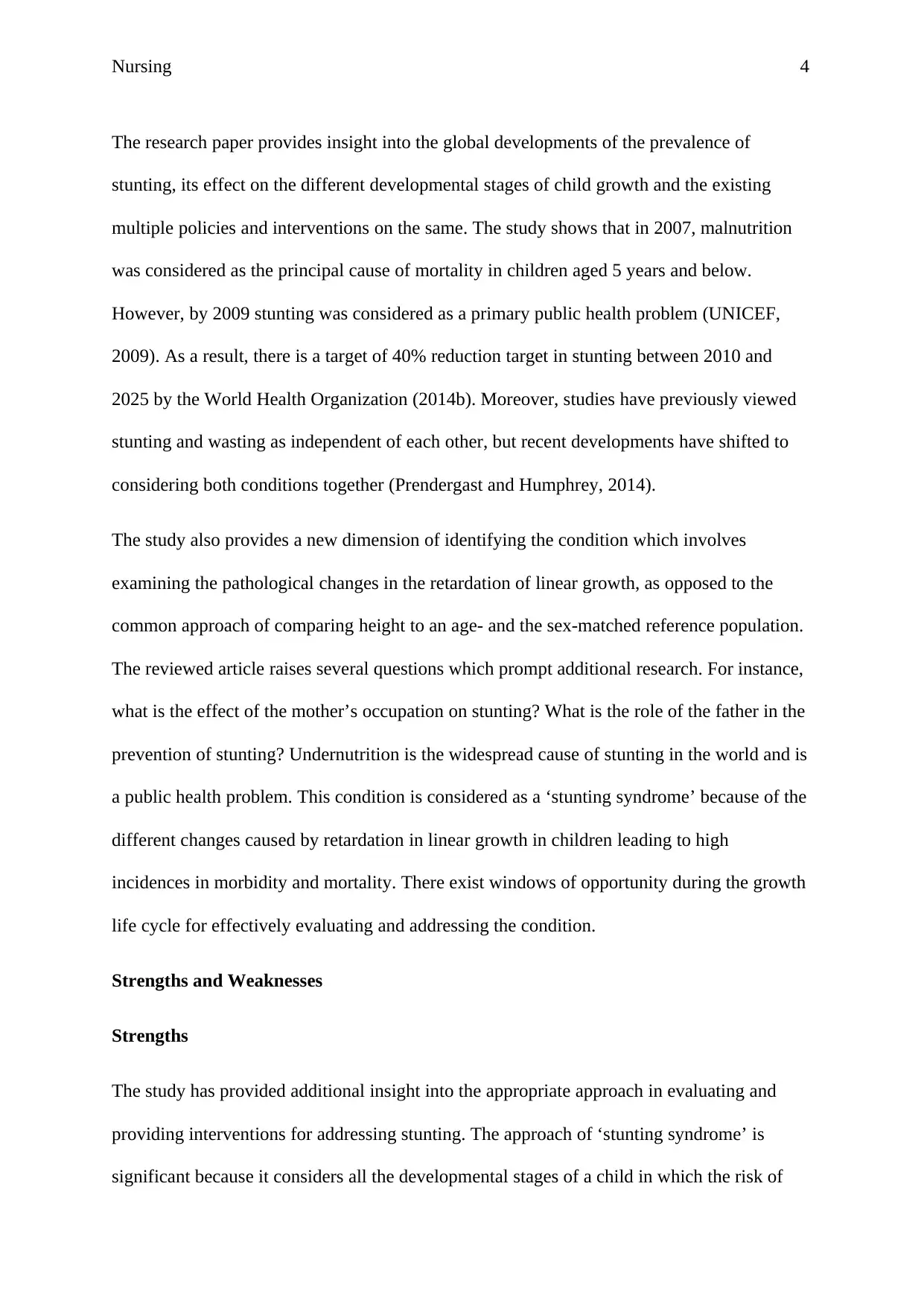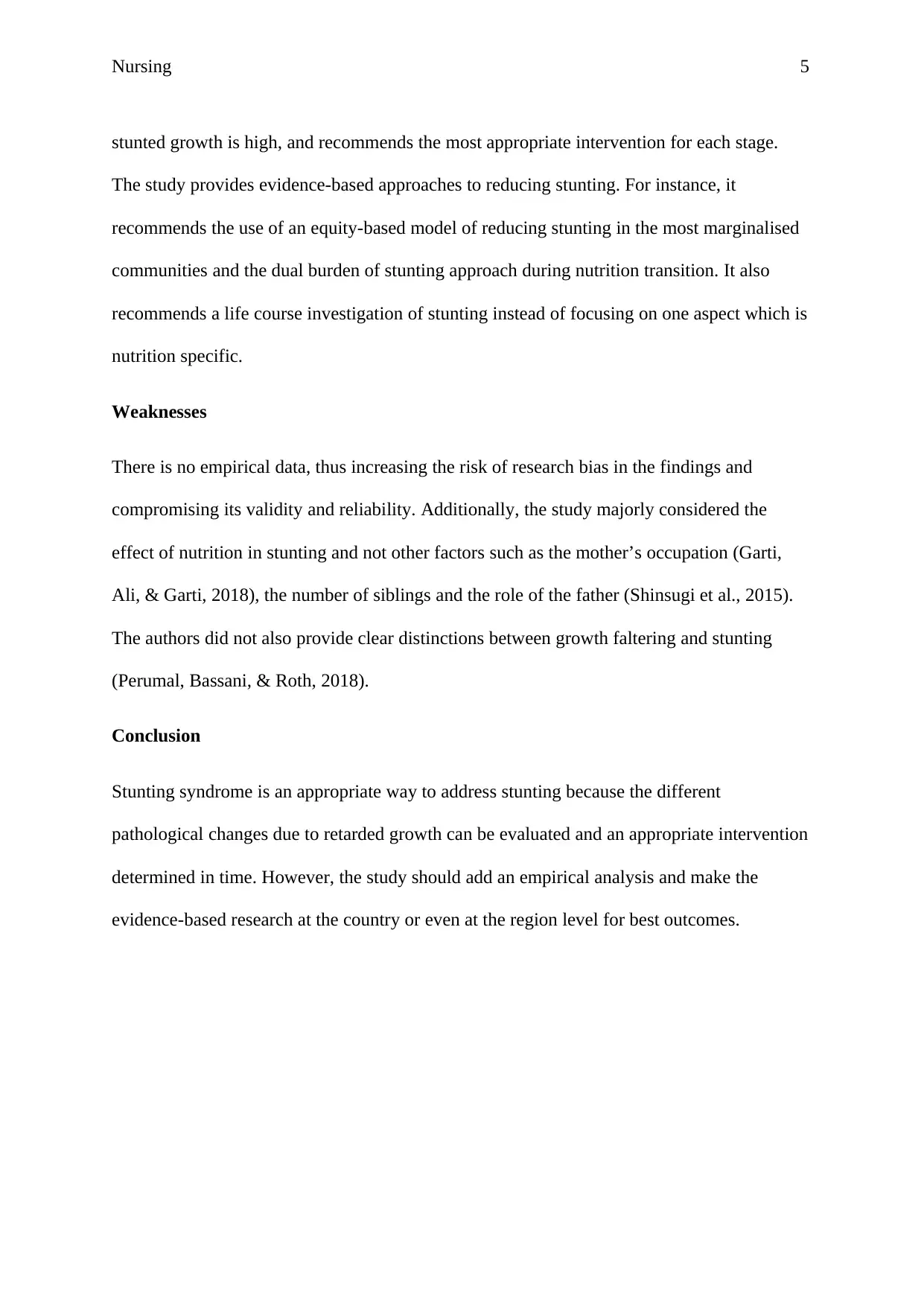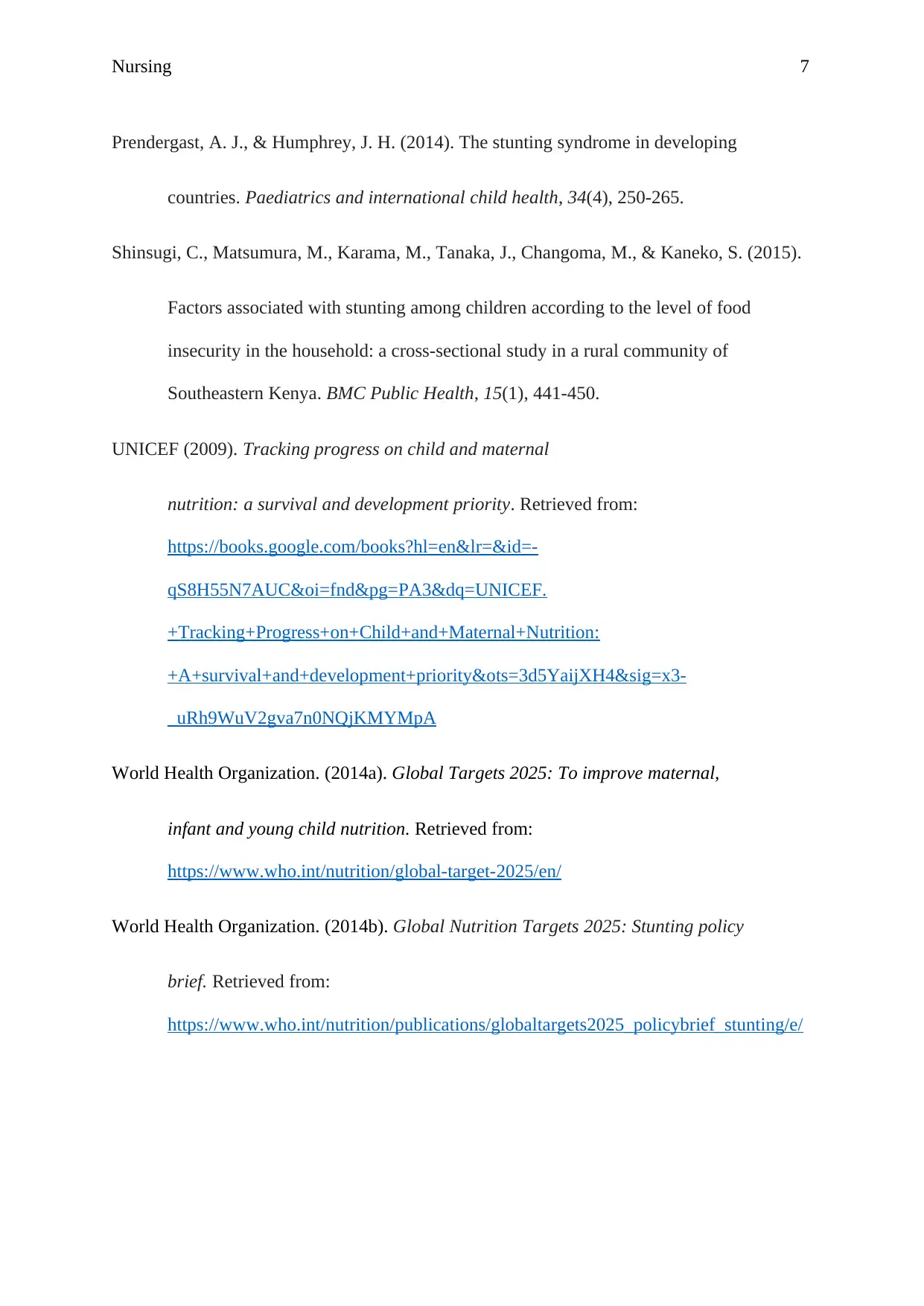Critical Assessment of Stunting Syndrome in Developing Countries
VerifiedAdded on 2023/04/07
|7
|1444
|406
Essay
AI Summary
This essay provides a critical assessment of the article "The Stunting Syndrome in Developing Countries" by Prendergast and Humphrey (2014), which explores the causes and interventions for stunting, a condition of impaired growth and development in children due to poor nutrition, infection, and insufficient stimulation. The essay reviews the article's literature, identifies the research question, dependent and independent variables, and evaluates the study's strengths and weaknesses, including the lack of empirical data. It highlights the article's contribution to understanding stunting as a global public health problem and the importance of addressing it through targeted interventions at different developmental stages. The essay concludes that the 'stunting syndrome' approach is appropriate but suggests incorporating empirical analysis for better outcomes. Desklib provides similar solved assignments for students.

Running head: Nursing 1
Nursing
by
Course:
Tutor:
University:
Department:
Date:
Nursing
by
Course:
Tutor:
University:
Department:
Date:
Paraphrase This Document
Need a fresh take? Get an instant paraphrase of this document with our AI Paraphraser

Nursing 2
Introduction
The article “The stunting syndrome in developing countries” by Prendergast and Humphrey
(2014) aims to explore and identify evidence for windows of opportunity for interventions by
reviewing the existing insight into growth failure in the development cycle. Stunting is the
impaired growth and development experienced by children due to poor nutrition, constant
infection, and insufficient psychological stimulation. A child is perceived to be stunted if the
“height for age” value is less than the double standard deviations below the median of the
population (World Health Organization, 2014a). Asia is leading in the prevalence of the most
stunted infants (about 100 million) across the globe, followed by Africa with a prevalence of
40% due to population growth and undernutrition (De Onis, Blössner,& Borghi, 2010). The
incidence of stunting should be addressed because the defect has for long been neglect and
yet it is a global health problem (UNICEF, 2009). Moreover, it hampers normal body growth
and development, thus affecting even the economic productivity of the adults.
This essay aims at critically assessing the study by Prendergast and Humphrey (2014) on the
Stunting Syndrome in Developing Countries. Additionally, the literature of the paper will be
explained with reference to the existing research, and a swot analysis conducted in order to
determine the value and relevance of its contribution. Previous studies viewed stunting and
wasting independently (McDonald et al., 2013), however current research considers both
conditions together (Khara, 2016).
Martorell and Zongrone (2012) observe that the core determinants of stunting include
environmental factors such as the status of maternal nutrition, feeding practices, the incidence
of infections, cleanliness, and accessibility to healthcare. Epidemiological studies have also
reported proximal determinants of stunting to include inadequate breastfeeding and other
feeding practices, repeated infections and nutritional insufficiencies (Black et al., 2013).
Introduction
The article “The stunting syndrome in developing countries” by Prendergast and Humphrey
(2014) aims to explore and identify evidence for windows of opportunity for interventions by
reviewing the existing insight into growth failure in the development cycle. Stunting is the
impaired growth and development experienced by children due to poor nutrition, constant
infection, and insufficient psychological stimulation. A child is perceived to be stunted if the
“height for age” value is less than the double standard deviations below the median of the
population (World Health Organization, 2014a). Asia is leading in the prevalence of the most
stunted infants (about 100 million) across the globe, followed by Africa with a prevalence of
40% due to population growth and undernutrition (De Onis, Blössner,& Borghi, 2010). The
incidence of stunting should be addressed because the defect has for long been neglect and
yet it is a global health problem (UNICEF, 2009). Moreover, it hampers normal body growth
and development, thus affecting even the economic productivity of the adults.
This essay aims at critically assessing the study by Prendergast and Humphrey (2014) on the
Stunting Syndrome in Developing Countries. Additionally, the literature of the paper will be
explained with reference to the existing research, and a swot analysis conducted in order to
determine the value and relevance of its contribution. Previous studies viewed stunting and
wasting independently (McDonald et al., 2013), however current research considers both
conditions together (Khara, 2016).
Martorell and Zongrone (2012) observe that the core determinants of stunting include
environmental factors such as the status of maternal nutrition, feeding practices, the incidence
of infections, cleanliness, and accessibility to healthcare. Epidemiological studies have also
reported proximal determinants of stunting to include inadequate breastfeeding and other
feeding practices, repeated infections and nutritional insufficiencies (Black et al., 2013).

Nursing 3
Different interventions and policies have been recommended in an effort to reduce the
incidences of stunting. For instance, total breastfeeding for half a year. Other interventions
have been aimed at cultivating feeding practices for children and new born and providing
feeding education on feeding to improve linear growth (Prendergast and Humphrey, 2014).
Literature Review
The article’s research question is not stated expressly but can be implied from the objective,
which is: What are the causes of the failure in linear growth and interventions to avert or
control stunting? The authors use an analytical model to explore the topic of study. The
theoretical assumptions and conclusions of the article are that stunting is a global public
health problem which has previously been ignored. However, its global prevalence has led to
ambitious targets aimed at minimizing the incidence by 40% between 2010 and 2025. By
definition, stunting is the impairment in the linear growth of a child, and thus the article
examines possible determinants of stunting and the effect of the condition on the different
developmental stages of the child within the first 1000 days or two years.
The literature section has also identified the dependent variable to be stunted growth which is
measured using the height-for-age Z-score. In other words, a child is considered stunted if
“height for age” value is less than the double standard deviations below the median of the
population. The independent variables are the determinants of stunting which include
environmental factors such as the status of maternal nutrition, feeding practices, the incidence
of infections, cleanliness, and accessibility to healthcare. Others also include inadequate
breastfeeding and complementary feeding practices, repeated infections and nutritional
insufficiencies (Prendergast and Humphrey, 2014). However, the article doesn’t indicate how
these variables are measured. Additionally, there are no empirical conclusions since the study
has adopted an analytical model.
Different interventions and policies have been recommended in an effort to reduce the
incidences of stunting. For instance, total breastfeeding for half a year. Other interventions
have been aimed at cultivating feeding practices for children and new born and providing
feeding education on feeding to improve linear growth (Prendergast and Humphrey, 2014).
Literature Review
The article’s research question is not stated expressly but can be implied from the objective,
which is: What are the causes of the failure in linear growth and interventions to avert or
control stunting? The authors use an analytical model to explore the topic of study. The
theoretical assumptions and conclusions of the article are that stunting is a global public
health problem which has previously been ignored. However, its global prevalence has led to
ambitious targets aimed at minimizing the incidence by 40% between 2010 and 2025. By
definition, stunting is the impairment in the linear growth of a child, and thus the article
examines possible determinants of stunting and the effect of the condition on the different
developmental stages of the child within the first 1000 days or two years.
The literature section has also identified the dependent variable to be stunted growth which is
measured using the height-for-age Z-score. In other words, a child is considered stunted if
“height for age” value is less than the double standard deviations below the median of the
population. The independent variables are the determinants of stunting which include
environmental factors such as the status of maternal nutrition, feeding practices, the incidence
of infections, cleanliness, and accessibility to healthcare. Others also include inadequate
breastfeeding and complementary feeding practices, repeated infections and nutritional
insufficiencies (Prendergast and Humphrey, 2014). However, the article doesn’t indicate how
these variables are measured. Additionally, there are no empirical conclusions since the study
has adopted an analytical model.
⊘ This is a preview!⊘
Do you want full access?
Subscribe today to unlock all pages.

Trusted by 1+ million students worldwide

Nursing 4
The research paper provides insight into the global developments of the prevalence of
stunting, its effect on the different developmental stages of child growth and the existing
multiple policies and interventions on the same. The study shows that in 2007, malnutrition
was considered as the principal cause of mortality in children aged 5 years and below.
However, by 2009 stunting was considered as a primary public health problem (UNICEF,
2009). As a result, there is a target of 40% reduction target in stunting between 2010 and
2025 by the World Health Organization (2014b). Moreover, studies have previously viewed
stunting and wasting as independent of each other, but recent developments have shifted to
considering both conditions together (Prendergast and Humphrey, 2014).
The study also provides a new dimension of identifying the condition which involves
examining the pathological changes in the retardation of linear growth, as opposed to the
common approach of comparing height to an age- and the sex-matched reference population.
The reviewed article raises several questions which prompt additional research. For instance,
what is the effect of the mother’s occupation on stunting? What is the role of the father in the
prevention of stunting? Undernutrition is the widespread cause of stunting in the world and is
a public health problem. This condition is considered as a ‘stunting syndrome’ because of the
different changes caused by retardation in linear growth in children leading to high
incidences in morbidity and mortality. There exist windows of opportunity during the growth
life cycle for effectively evaluating and addressing the condition.
Strengths and Weaknesses
Strengths
The study has provided additional insight into the appropriate approach in evaluating and
providing interventions for addressing stunting. The approach of ‘stunting syndrome’ is
significant because it considers all the developmental stages of a child in which the risk of
The research paper provides insight into the global developments of the prevalence of
stunting, its effect on the different developmental stages of child growth and the existing
multiple policies and interventions on the same. The study shows that in 2007, malnutrition
was considered as the principal cause of mortality in children aged 5 years and below.
However, by 2009 stunting was considered as a primary public health problem (UNICEF,
2009). As a result, there is a target of 40% reduction target in stunting between 2010 and
2025 by the World Health Organization (2014b). Moreover, studies have previously viewed
stunting and wasting as independent of each other, but recent developments have shifted to
considering both conditions together (Prendergast and Humphrey, 2014).
The study also provides a new dimension of identifying the condition which involves
examining the pathological changes in the retardation of linear growth, as opposed to the
common approach of comparing height to an age- and the sex-matched reference population.
The reviewed article raises several questions which prompt additional research. For instance,
what is the effect of the mother’s occupation on stunting? What is the role of the father in the
prevention of stunting? Undernutrition is the widespread cause of stunting in the world and is
a public health problem. This condition is considered as a ‘stunting syndrome’ because of the
different changes caused by retardation in linear growth in children leading to high
incidences in morbidity and mortality. There exist windows of opportunity during the growth
life cycle for effectively evaluating and addressing the condition.
Strengths and Weaknesses
Strengths
The study has provided additional insight into the appropriate approach in evaluating and
providing interventions for addressing stunting. The approach of ‘stunting syndrome’ is
significant because it considers all the developmental stages of a child in which the risk of
Paraphrase This Document
Need a fresh take? Get an instant paraphrase of this document with our AI Paraphraser

Nursing 5
stunted growth is high, and recommends the most appropriate intervention for each stage.
The study provides evidence-based approaches to reducing stunting. For instance, it
recommends the use of an equity-based model of reducing stunting in the most marginalised
communities and the dual burden of stunting approach during nutrition transition. It also
recommends a life course investigation of stunting instead of focusing on one aspect which is
nutrition specific.
Weaknesses
There is no empirical data, thus increasing the risk of research bias in the findings and
compromising its validity and reliability. Additionally, the study majorly considered the
effect of nutrition in stunting and not other factors such as the mother’s occupation (Garti,
Ali, & Garti, 2018), the number of siblings and the role of the father (Shinsugi et al., 2015).
The authors did not also provide clear distinctions between growth faltering and stunting
(Perumal, Bassani, & Roth, 2018).
Conclusion
Stunting syndrome is an appropriate way to address stunting because the different
pathological changes due to retarded growth can be evaluated and an appropriate intervention
determined in time. However, the study should add an empirical analysis and make the
evidence-based research at the country or even at the region level for best outcomes.
stunted growth is high, and recommends the most appropriate intervention for each stage.
The study provides evidence-based approaches to reducing stunting. For instance, it
recommends the use of an equity-based model of reducing stunting in the most marginalised
communities and the dual burden of stunting approach during nutrition transition. It also
recommends a life course investigation of stunting instead of focusing on one aspect which is
nutrition specific.
Weaknesses
There is no empirical data, thus increasing the risk of research bias in the findings and
compromising its validity and reliability. Additionally, the study majorly considered the
effect of nutrition in stunting and not other factors such as the mother’s occupation (Garti,
Ali, & Garti, 2018), the number of siblings and the role of the father (Shinsugi et al., 2015).
The authors did not also provide clear distinctions between growth faltering and stunting
(Perumal, Bassani, & Roth, 2018).
Conclusion
Stunting syndrome is an appropriate way to address stunting because the different
pathological changes due to retarded growth can be evaluated and an appropriate intervention
determined in time. However, the study should add an empirical analysis and make the
evidence-based research at the country or even at the region level for best outcomes.

Nursing 6
References
Black, R. E., Victora, C. G., Walker, S. P., Bhutta, Z. A., Christian, P., De Onis, M., ... &
Uauy, R. (2013). Maternal and child undernutrition and overweight in low-income
and middle-income countries. The lancet, 382(9890), 427-451.
De Onis, M., Blössner, M., & Borghi, E. (2010). Global prevalence and trends of overweight
and obesity among preschool children. The American journal of clinical
nutrition, 92(5), 1257-1264.
Garti, H., Ali, Z., & Garti, H. A. (2018). Maternal daily work hours affect nutritional status of
children in Northern Ghana. Nutrire, 43(1), 16-18.
Khara, T. (2016). The relationship between wasting and stunting: policy, programming and
research implications. Field Exchange 50, 23-27.
Martorell, R., & Zongrone, A. (2012). Intergenerational influences on child growth and
undernutrition. Paediatric and perinatal epidemiology, 26, 302-314.
McDonald, C. M., Olofin, I., Flaxman, S., Fawzi, W. W., Spiegelman, D., Caulfield, L. E., ...
& Nutrition Impact Model Study. (2013). The effect of multiple anthropometric
deficits on child mortality: meta-analysis of individual data in 10 prospective studies
from developing countries. The American journal of clinical nutrition, 97(4), 896-
901.
Perumal, N., Bassani, D. G., & Roth, D. E. (2018). Use and misuse of stunting as a measure
of child health. The Journal of nutrition, 148(3), 311-315.
References
Black, R. E., Victora, C. G., Walker, S. P., Bhutta, Z. A., Christian, P., De Onis, M., ... &
Uauy, R. (2013). Maternal and child undernutrition and overweight in low-income
and middle-income countries. The lancet, 382(9890), 427-451.
De Onis, M., Blössner, M., & Borghi, E. (2010). Global prevalence and trends of overweight
and obesity among preschool children. The American journal of clinical
nutrition, 92(5), 1257-1264.
Garti, H., Ali, Z., & Garti, H. A. (2018). Maternal daily work hours affect nutritional status of
children in Northern Ghana. Nutrire, 43(1), 16-18.
Khara, T. (2016). The relationship between wasting and stunting: policy, programming and
research implications. Field Exchange 50, 23-27.
Martorell, R., & Zongrone, A. (2012). Intergenerational influences on child growth and
undernutrition. Paediatric and perinatal epidemiology, 26, 302-314.
McDonald, C. M., Olofin, I., Flaxman, S., Fawzi, W. W., Spiegelman, D., Caulfield, L. E., ...
& Nutrition Impact Model Study. (2013). The effect of multiple anthropometric
deficits on child mortality: meta-analysis of individual data in 10 prospective studies
from developing countries. The American journal of clinical nutrition, 97(4), 896-
901.
Perumal, N., Bassani, D. G., & Roth, D. E. (2018). Use and misuse of stunting as a measure
of child health. The Journal of nutrition, 148(3), 311-315.
⊘ This is a preview!⊘
Do you want full access?
Subscribe today to unlock all pages.

Trusted by 1+ million students worldwide

Nursing 7
Prendergast, A. J., & Humphrey, J. H. (2014). The stunting syndrome in developing
countries. Paediatrics and international child health, 34(4), 250-265.
Shinsugi, C., Matsumura, M., Karama, M., Tanaka, J., Changoma, M., & Kaneko, S. (2015).
Factors associated with stunting among children according to the level of food
insecurity in the household: a cross-sectional study in a rural community of
Southeastern Kenya. BMC Public Health, 15(1), 441-450.
UNICEF (2009). Tracking progress on child and maternal
nutrition: a survival and development priority. Retrieved from:
https://books.google.com/books?hl=en&lr=&id=-
qS8H55N7AUC&oi=fnd&pg=PA3&dq=UNICEF.
+Tracking+Progress+on+Child+and+Maternal+Nutrition:
+A+survival+and+development+priority&ots=3d5YaijXH4&sig=x3-
_uRh9WuV2gva7n0NQjKMYMpA
World Health Organization. (2014a). Global Targets 2025: To improve maternal,
infant and young child nutrition. Retrieved from:
https://www.who.int/nutrition/global-target-2025/en/
World Health Organization. (2014b). Global Nutrition Targets 2025: Stunting policy
brief. Retrieved from:
https://www.who.int/nutrition/publications/globaltargets2025_policybrief_stunting/e/
Prendergast, A. J., & Humphrey, J. H. (2014). The stunting syndrome in developing
countries. Paediatrics and international child health, 34(4), 250-265.
Shinsugi, C., Matsumura, M., Karama, M., Tanaka, J., Changoma, M., & Kaneko, S. (2015).
Factors associated with stunting among children according to the level of food
insecurity in the household: a cross-sectional study in a rural community of
Southeastern Kenya. BMC Public Health, 15(1), 441-450.
UNICEF (2009). Tracking progress on child and maternal
nutrition: a survival and development priority. Retrieved from:
https://books.google.com/books?hl=en&lr=&id=-
qS8H55N7AUC&oi=fnd&pg=PA3&dq=UNICEF.
+Tracking+Progress+on+Child+and+Maternal+Nutrition:
+A+survival+and+development+priority&ots=3d5YaijXH4&sig=x3-
_uRh9WuV2gva7n0NQjKMYMpA
World Health Organization. (2014a). Global Targets 2025: To improve maternal,
infant and young child nutrition. Retrieved from:
https://www.who.int/nutrition/global-target-2025/en/
World Health Organization. (2014b). Global Nutrition Targets 2025: Stunting policy
brief. Retrieved from:
https://www.who.int/nutrition/publications/globaltargets2025_policybrief_stunting/e/
1 out of 7
Your All-in-One AI-Powered Toolkit for Academic Success.
+13062052269
info@desklib.com
Available 24*7 on WhatsApp / Email
![[object Object]](/_next/static/media/star-bottom.7253800d.svg)
Unlock your academic potential
Copyright © 2020–2025 A2Z Services. All Rights Reserved. Developed and managed by ZUCOL.